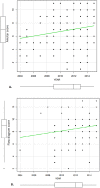Quality of flow diagram in systematic review and/or meta-analysis
- PMID: 29949595
- PMCID: PMC6021048
- DOI: 10.1371/journal.pone.0195955
Quality of flow diagram in systematic review and/or meta-analysis
Abstract
Systematic reviews and/or meta-analyses generally provide the best evidence for medical research. Authors are recommended to use flow diagrams to present the review process, allowing for better understanding among readers. However, no studies as of yet have assessed the quality of flow diagrams in systematic review/meta-analyses. Our study aims to evaluate the quality of systematic review/meta-analyses over a period of ten years, by assessing the quality of the flow diagrams, and the correlation to the methodological quality. Two hundred articles of "systematic review" and/or "meta-analysis" from January 2004 to August 2015 were randomly retrieved in Pubmed to be assessed for the flow diagram and methodological qualities. The flow diagrams were evaluated using a 16-grade scale corresponding to the four stages of PRISMA flow diagram. It composes four parts: Identification, Screening, Eligibility and Inclusion. Of the 200 articles screened, 154 articles were included and were assessed with AMSTAR checklist. Among them, 78 articles (50.6%) had the flow diagram. Over ten years, the proportion of papers with flow diagram available had been increasing significantly with regression coefficient beta = 5.649 (p = 0.002). However, the improvement in quality of the flow diagram increased slightly but not significantly (regression coefficient beta = 0.177, p = 0.133). Our analysis showed high variation in the proportion of articles that reported flow diagram components. The lowest proportions were 1% for reporting methods of duplicates removal in screening phase, followed by 6% for manual search in identification phase, 22% for number of studies for each specific/subgroup analysis, 27% for number of articles retrieved from each database, and 31% for number of studies included in qualitative analysis. The flow diagram quality was correlated with the methodological quality with the Pearson's coefficient r = 0.32 (p = 0.0039). Therefore, this review suggests that the reporting quality of flow diagram is less satisfactory, hence not maximizing the potential benefit of the flow diagrams. A guideline with standardized flow diagram is recommended to improve the quality of systematic reviews, and to enable better reader comprehension of the review process.
Conflict of interest statement
The authors have declared that no competing interests exist.
Figures







Similar articles
-
Reporting and Methodological Quality of Systematic Reviews and Meta-Analyses of Nursing Interventions in Patients With Alzheimer's Disease: General Implications of the Findings.J Nurs Scholarsh. 2019 May;51(3):308-316. doi: 10.1111/jnu.12462. Epub 2019 Feb 25. J Nurs Scholarsh. 2019. PMID: 30806019
-
The future of Cochrane Neonatal.Early Hum Dev. 2020 Nov;150:105191. doi: 10.1016/j.earlhumdev.2020.105191. Epub 2020 Sep 12. Early Hum Dev. 2020. PMID: 33036834
-
A Critical Analysis of Reporting in Systematic Reviews and Meta-Analyses in the Peyronie's Disease Literature.J Sex Med. 2022 Apr;19(4):629-640. doi: 10.1016/j.jsxm.2022.01.008. Epub 2022 Feb 15. J Sex Med. 2022. PMID: 35177375 Free PMC article.
-
Reporting and methodological quality of systematic reviews and meta-analysis with protocols in Diabetes Mellitus Type II: A systematic review.PLoS One. 2020 Dec 16;15(12):e0243091. doi: 10.1371/journal.pone.0243091. eCollection 2020. PLoS One. 2020. PMID: 33326429 Free PMC article.
-
Appraising the Quality of Systematic Reviews for Age-Related Macular Degeneration Interventions: A Systematic Review.JAMA Ophthalmol. 2018 Sep 1;136(9):1051-1061. doi: 10.1001/jamaophthalmol.2018.2620. JAMA Ophthalmol. 2018. PMID: 29978192
Cited by
-
Ten simple rules for carrying out and writing meta-analyses.PLoS Comput Biol. 2019 May 16;15(5):e1006922. doi: 10.1371/journal.pcbi.1006922. eCollection 2019 May. PLoS Comput Biol. 2019. PMID: 31095553 Free PMC article. No abstract available.
-
The Effect of Maternal Depression on Infant Attachment: A Systematic Review.Int J Environ Res Public Health. 2020 Apr 14;17(8):2675. doi: 10.3390/ijerph17082675. Int J Environ Res Public Health. 2020. PMID: 32295106 Free PMC article.
-
How to Conduct a Systematic Review and Meta-Analysis: A Guide for Clinicians.Respir Care. 2023 Sep;68(9):1295-1308. doi: 10.4187/respcare.10971. Epub 2023 Apr 18. Respir Care. 2023. PMID: 37072163 Free PMC article.
-
Management of Peri-Implantitis Lesions without the Use of Systemic Antibiotics: A Systematic Review.Dent J (Basel). 2020 Sep 14;8(3):106. doi: 10.3390/dj8030106. Dent J (Basel). 2020. PMID: 32937892 Free PMC article. Review.
-
PRISMA2020: An R package and Shiny app for producing PRISMA 2020-compliant flow diagrams, with interactivity for optimised digital transparency and Open Synthesis.Campbell Syst Rev. 2022 Mar 27;18(2):e1230. doi: 10.1002/cl2.1230. eCollection 2022 Jun. Campbell Syst Rev. 2022. PMID: 36911350 Free PMC article.
References
-
- Cook DJ, Mulrow CD & Haynes RB. Systematic Reviews: Synthesis of Best Evidence for Clinical Decisions. Ann Intern Med. 1997; 126: 376–380. - PubMed
-
- Akobeng AK. Understanding systematic reviews and meta-analysis. Arch Dis Child. 2005; 90: 845–848. doi: 10.1136/adc.2004.058230 - DOI - PMC - PubMed
-
- Hemmingway P & Brereton N. What is a systematic review? London: Hayward Medical Communications; 2009; 8.
-
- Higgins JPT & Green S (editors). Cochrane Handbook for Systematic Reviews of Interventions Version 5.1.0 2011.
MeSH terms
LinkOut - more resources
Full Text Sources
Other Literature Sources

